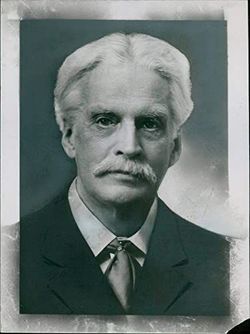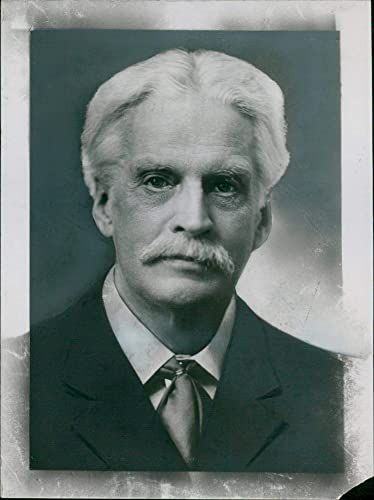Balfour was the fourth son of James Maitland Balfour, of Whittingehame, Haddingtonshire, and Lady Blanche Cecil, daughter of James Gascoyne-Cecil, 2nd Marquess of Salisbury. Two Prime Ministers were immediate relations: Arthur Balfour, 1st Earl of Balfour, his elder brother, and Lord Salisbury, his uncle. He was educated at Eton and at Trinity College, Cambridge, where he gained 1st Class Honours in the Classical Tripos.
Balfour sat as Conservative Member of Parliament for Leeds Central from 1885 to 1906. During this time he was a member of Commission on Labour, and private secretary to his brother, Arthur Balfour, when he was president of the Local Government Board from 1885 to 1886. He served as Chief Secretary for Ireland from 1895 to 1900, as president of the Board of Trade from 1900 to 1905 and as president of the Local Government Board in 1905. He was admitted to the Privy Council of Ireland in 1895, and to the Privy Council of the United Kingdom in 1905.
On retiring from the House of Commons, he was chairman of the Commission on Lighthouse Administration in 1908, and chairman of the Cambridge Committee of the Commission on Oxford and Cambridge Universities. He succeeded his brother Arthur as second Earl of Balfour in 1930, according to a special remainder in the letters patent and took a seat in the House of Lords.
During his first spell at the Houses of Parliament, Balfour received an honorary LLD from Cambridge University, and was a fellow of Trinity.
From 1901 Balfour lived at Fisher's Hill House, a large home which he had built by Lutyens in Hook Heath, Woking, Surrey, also living in the rural hamlet by 1911 were Alfred Lyttelton (Lib. U.), Secretary of State for the Colonies (1903-1905) who married into his wider family and the Duke of Sutherland.
Lord Balfour married Lady Elizabeth Edith "Betty" Bulwer-Lytton, daughter of Robert Bulwer-Lytton, 1st Earl of Lytton, in 1887. They had six children:
Lady Eleanor Balfour
Lady Ruth Balfour (d. 30 August 1967)
Mary Edith Balfour (d. 21 January 1894)
Lady Evelyn Barbara "Eve" Balfour (16 July 1898 - 1990)
Robert Arthur Lytton Balfour, 3rd Earl of Balfour (31 December 1902 - 28 November 1968)
Lady Kathleen Constance Blanche Balfour (1912 - 20 August 1996).
The Countess of Balfour died in 1942, aged 74. Lord Balfour survived her by three years and died in January 1945, aged 91, by which time he was the last surviving member of any of long-serving Prime Minister Salisbury's cabinets. He was succeeded in the earldom by his only son Robert.
Balfour was the fourth son of James Maitland Balfour, of Whittingehame, Haddingtonshire, and Lady Blanche Cecil, daughter of James Gascoyne-Cecil, 2nd Marquess of Salisbury. Two Prime Ministers were immediate relations: Arthur Balfour, 1st Earl of Balfour, his elder brother, and Lord Salisbury, his uncle. He was educated at Eton and at Trinity College, Cambridge, where he gained 1st Class Honours in the Classical Tripos.
Balfour sat as Conservative Member of Parliament for Leeds Central from 1885 to 1906. During this time he was a member of Commission on Labour, and private secretary to his brother, Arthur Balfour, when he was president of the Local Government Board from 1885 to 1886. He served as Chief Secretary for Ireland from 1895 to 1900, as president of the Board of Trade from 1900 to 1905 and as president of the Local Government Board in 1905. He was admitted to the Privy Council of Ireland in 1895, and to the Privy Council of the United Kingdom in 1905.
On retiring from the House of Commons, he was chairman of the Commission on Lighthouse Administration in 1908, and chairman of the Cambridge Committee of the Commission on Oxford and Cambridge Universities. He succeeded his brother Arthur as second Earl of Balfour in 1930, according to a special remainder in the letters patent and took a seat in the House of Lords.
During his first spell at the Houses of Parliament, Balfour received an honorary LLD from Cambridge University, and was a fellow of Trinity.
From 1901 Balfour lived at Fisher's Hill House, a large home which he had built by Lutyens in Hook Heath, Woking, Surrey, also living in the rural hamlet by 1911 were Alfred Lyttelton (Lib. U.), Secretary of State for the Colonies (1903-1905) who married into his wider family and the Duke of Sutherland.
Lord Balfour married Lady Elizabeth Edith "Betty" Bulwer-Lytton, daughter of Robert Bulwer-Lytton, 1st Earl of Lytton, in 1887. They had six children:
Lady Eleanor Balfour
Lady Ruth Balfour (d. 30 August 1967)
Mary Edith Balfour (d. 21 January 1894)
Lady Evelyn Barbara "Eve" Balfour (16 July 1898 - 1990)
Robert Arthur Lytton Balfour, 3rd Earl of Balfour (31 December 1902 - 28 November 1968)
Lady Kathleen Constance Blanche Balfour (1912 - 20 August 1996).
The Countess of Balfour died in 1942, aged 74. Lord Balfour survived her by three years and died in January 1945, aged 91, by which time he was the last surviving member of any of long-serving Prime Minister Salisbury's cabinets. He was succeeded in the earldom by his only son Robert.
Family Members
Sponsored by Ancestry
Advertisement
Records on Ancestry
Sponsored by Ancestry
Advertisement









